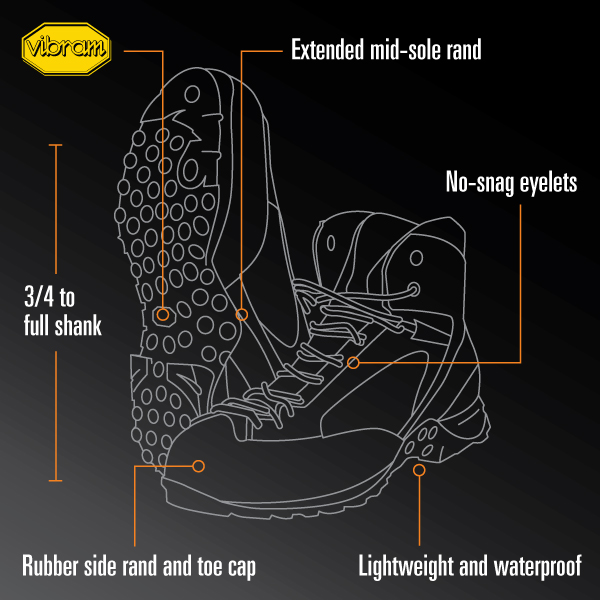Size, style, comfort and quality play a major role in the decision making process, but prospective owners should also look for a few key features before they invest in a new pair of tree climbing boots.
The list below is generic and covers chainsaw protective and non-protective tree climbing boots.
If you are planning to wear climbers or spurs you will also need to consider the depth of the heel - there is a trend in modern work boots to make them more 'sneaker-like'. A flat-sole, shank-less style boot is completely useless for wearing climbers, spurs or gaffs so make sure you have a traditional heel plate.
1) Three-quarter to full length shank
The 'shank' provides solid support for the foot. Sandwiched between the insole and the outsole of the boot, the shank reduces the load on your feet and calves during ascent, or when standing stationery supporting yourself on a small stub or branch with your toe.
Generally speaking, the longer the shank the stiffer the boot. A boot with no shank can be bent in half like a pair of jandals so a shank-less boot is very easy to identify.
Unfortunately a climbing boot with a shank does not feel very comfortable on first wear. This aspect often dampens the 'retail experience' but a full-shanked boot is worth persevering with, in terms of comfort, particularly if you plan to wear climbers.
2) No-snag eyelets
This one speaks for itself. A lot of high-style tree climbing boots feature fiddly (read breakable) eyelets - flashy eyelets look good but do not last the distance, snapping off long before the boot itself is worn out - these eyelets tend to get snagged on everything in their way, from the bottom of your trousers to every small branch or twig in the tree!
3) Rubber toecaps with side and mid-sole rand
Tree climbers jam their boot into all sorts of tight spots! The sideways loading when the boot is wedged in a tight crotch produces wear well up the side of the boot. Most non-tree climbing boots, without a deep rand, wear out prematurely at this point.The rand also offers protection from the shaft when wearing climbers.
If possible look for a boot where the rand runs slightly higher in the mid-sole, between the heel and the toe. When foot locking this section of the boot takes the most load. The friction produced on contact with the rope and the boot sole will wear excessively at this point if the extended rand is not present.
4) Quality sole (Vibram is a good benchmark)
Apart from tread pattern look for a sole that is not too hard and not too soft. The sole on some tree climbing boots is very soft, great for gripping the cambium in the wet and very gentle on the tree - but you will wear the sole off the boot in a short space of time if worn on concrete or asphalt. One test is to run your thumb over the 'rubber' sole of the boot. The softer and more grippy the feel, the less life you can expect when the boot is not worn in the tree.
5) Lightweight, waterproof and breathable
Climbing around with 1-2kg strapped to each foot is not going to make for a very pleasant day of tree climbing. Go for a lighter weight wherever possible but balance weight against overall quality - some 'lightweight' boots simply will not last the distance.
Better quality boots feature waterproof, breathable inner liners, usually consisting of a 'tex' fabric of some description; Goretex, Windtex, etc. This technical fabric keeps your foot dry by allowing heat to dissipate, reducing sweat build-up.

